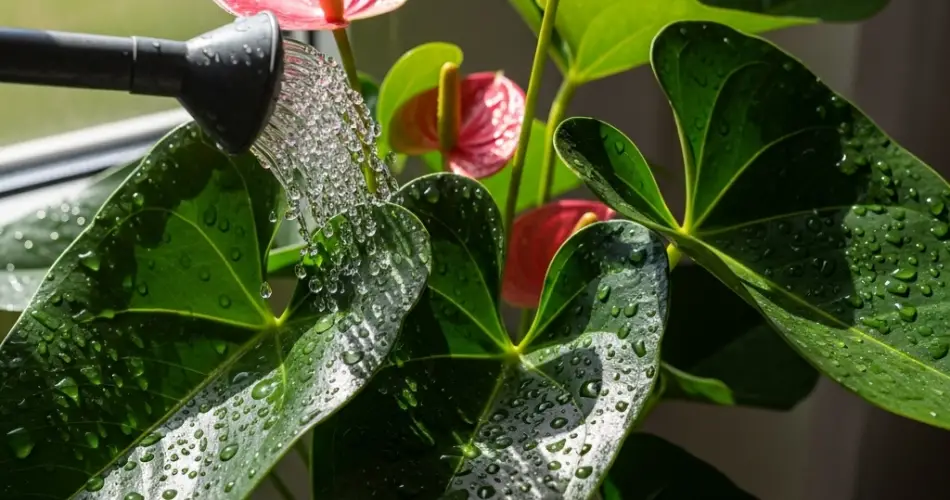The Flamingo Flower, also known as Anthurium andraeanum, is a tropical beauty admired for its glossy, heart-shaped leaves and long-lasting, vibrant blooms. Though it’s relatively easy to care for, one of the most common problems houseplant owners face with this plant is root rot—typically caused by improper watering practices. Learning how to water the Flamingo Flower correctly is the key to keeping it healthy, blooming, and free from fungal diseases.
In this article, we’ll explore how to water your Flamingo Flower the right way, identify the signs of overwatering, and prevent root rot from taking hold.
Understanding Flamingo Flower’s Water Needs
Flamingo Flowers originate from the rainforests of Central and South America, where they grow in moist but well-draining environments. While they enjoy consistent moisture, they do not tolerate soggy soil. This balance—keeping the roots moist but not waterlogged—is critical.
During the growing season (spring and summer), they require more frequent watering. In cooler months, their growth slows, and they need less water.
Best Practices for Watering Flamingo Flower
1. Water Only When the Topsoil Is Dry
A simple but effective method is to insert your finger about 1 to 2 inches into the soil. If it feels dry, it’s time to water. If it’s still slightly damp, wait a couple more days. Flamingo Flowers are more tolerant of slightly dry conditions than constantly wet roots.
Avoid watering on a fixed schedule. Instead, check the soil moisture regularly and adjust based on temperature, humidity, and season.
2. Use Room Temperature Water
Cold water can shock the roots, especially in tropical plants. Always use room temperature water to avoid root stress. Let tap water sit for a few hours before watering to allow chlorine to dissipate, or use filtered water for sensitive plants.
3. Water Thoroughly, Then Let Drain
When it’s time to water, do so thoroughly. Pour water evenly across the surface of the soil until it starts draining out of the bottom. This ensures all the roots are moistened. Discard any excess water from the saucer beneath the pot—never let your plant sit in standing water.
This “deep watering” approach supports healthy root development and discourages shallow roots.
4. Choose the Right Soil and Pot
Using the correct soil mix is just as important as watering habits. Flamingo Flowers prefer a well-aerated, fast-draining mix. A combination of orchid bark, peat moss, and perlite works well. You can also use a commercial potting mix formulated for aroids or epiphytic tropicals.
The pot should have good drainage holes. Avoid decorative pots with no drainage, as they trap water and increase the risk of root rot.
5. Reduce Watering in Winter
Flamingo Flowers slow down in colder months, requiring less frequent watering. Overwatering during dormancy is one of the main reasons plants develop root rot during winter. Continue checking the soil before watering, and expect to water less often—possibly every two to three weeks, depending on indoor conditions.
How to Recognize Overwatering and Root Rot
Catching early signs of overwatering can save your plant. Symptoms include:
-
Yellowing or browning leaves, especially lower ones
-
Wilting, even though the soil is moist
-
A musty smell coming from the soil
-
Mushy or blackened roots when removed from the pot
If you suspect root rot, take action immediately. Remove the plant from the pot, trim off any soft or discolored roots, and repot into fresh, dry, well-draining soil. Clean the pot thoroughly before reuse.
Bonus Tips for Humidity-Loving Flamingo Flowers
Flamingo Flowers enjoy high humidity, which can sometimes confuse growers into overwatering. Remember, humidity affects the plant’s leaves, not the roots.
You can increase humidity by:
-
Placing the pot on a pebble tray with water (without letting the pot touch the water)
-
Using a room humidifier
-
Grouping plants together to create a microclimate
Don’t try to compensate for dry air by watering more frequently—that approach increases the chance of root rot without benefiting the plant.
Final Thoughts
Watering your Flamingo Flower correctly is all about balance: enough moisture to mimic its tropical origins, but never so much that the roots stay wet. By checking soil moisture before watering, choosing the right potting mix and container, and adjusting your watering schedule based on the seasons, you can avoid root rot and enjoy a thriving, blooming plant year-round.
Consistent care and attention to your plant’s signals will go a long way in keeping your Flamingo Flower healthy, vibrant, and free from disease.



